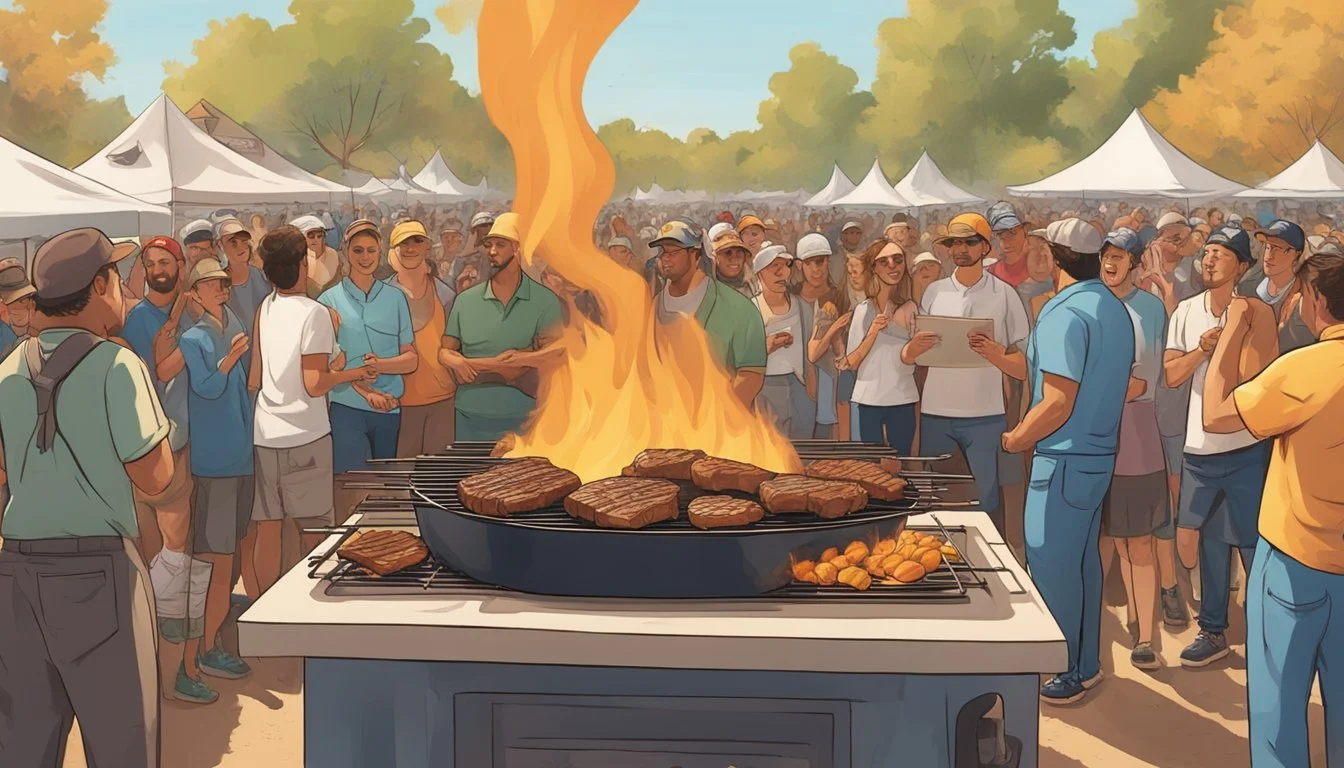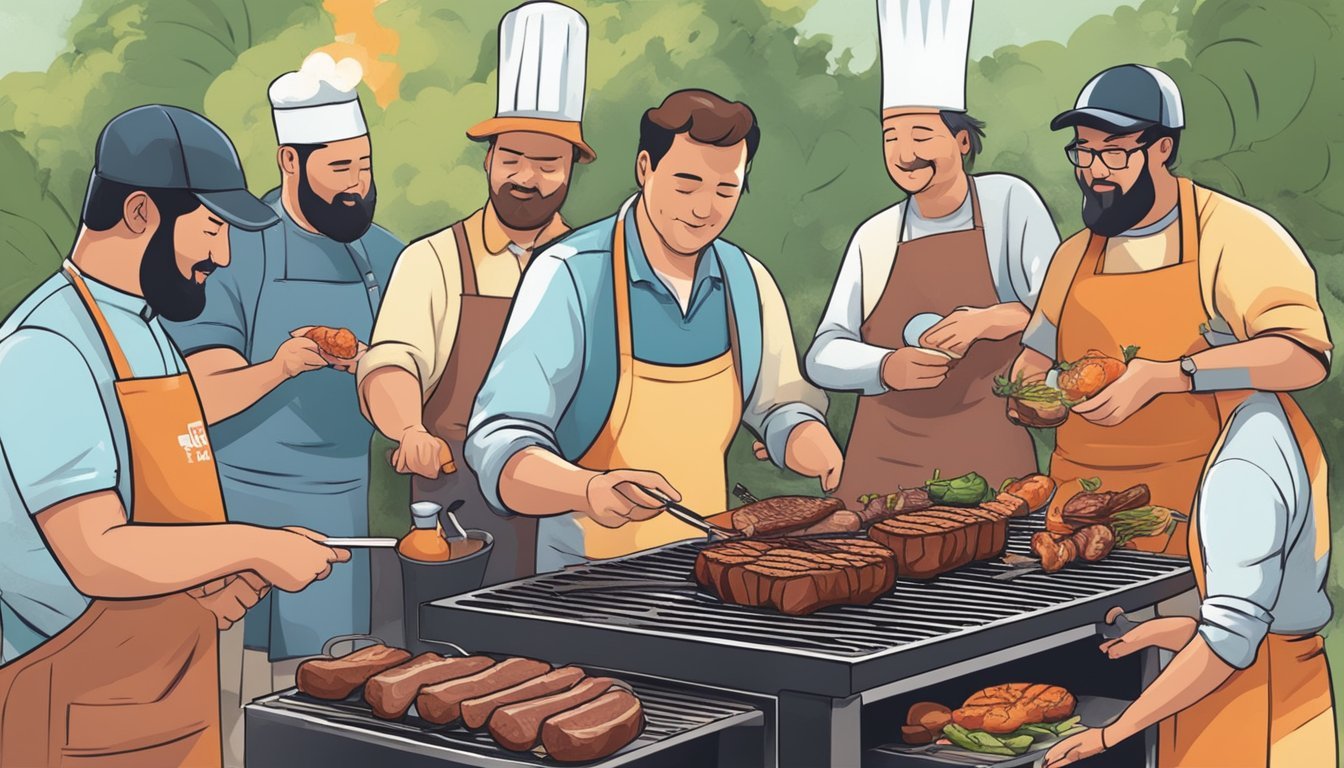South Dakota: The Chislic Challenge
Exploring the State's Signature Dish
South Dakota, a state renowned for its great faces and great places, is also home to a unique culinary delicacy: chislic. This dish of skewered and grilled cubes of meat is an integral part of South Dakotan identity, enjoyed at local eateries and festivals alike. Chislic varies by preparation with different meats being used, commonly mutton, lamb, beef, or venison (What wine goes well with venison?), and it taps into the rich tapestry of the state's culinary traditions.
For the adventurous food lovers, the Chislic Challenge offers not just a taste of this regional specialty but also tests the mettle of participants. The challenge entails consuming large quantities of chislic in a set time, showcasing the dish as a hearty staple that reflects the spirit of South Dakota. Neutral in its nature, the Chislic Challenge mirrors the rugged landscapes and the determination of those who call the state home.
As a testament to its popularity, chislic was honored as the official state "nosh" by South Dakota, symbolizing its significance in the region's culture. The challenge and the festivals surrounding it attract both locals and tourists, adding it to the list of must-try American food experiences. Visitors to South Dakota can partake in this time-honored tradition, sitting down to skewers of meat that carry with them a sense of place and history.
The Origins of Chislic
The journey of chislic reveals a multifaceted history, from its Eurasian roots to its embrace by South Dakota culture, underscored by the fascinating nuances of immigration and culinary adaptation.
Historical Backdrop
Chislic as a culinary tradition found its way to South Dakota in the latter half of the 19th century, with records pinpointing its advent to around the 1870s. It became deeply embedded in the region's food identity, particularly after South Dakota's statehood in 1889.
German Russian Influence
The arrival of German Russians, including immigrants from the Crimea region like John Hoellwarth, was pivotal in chislic's popularization. These communities brought their customary cooking techniques and flavors, integrating them into the local agricultural fabric. Their influence is particularly noticeable in the use of mutton and lamb, which were prevalent choices of meat for their chislic recipes.
Turkic and Arabic Connections
Chislic's etymological roots trace back to Turkic words like "shashlik," denoting skewered meats which closely resemble the Turkish and Arabic term "shish kebab." The dish underwent an anglicized transformation in South Dakota, evolving from grilled skewers to the now-common preparation method of deep-fat frying or grilling salted cubes of meat.
Chislic in South Dakota
Chislic, a distinctive meat dish with deep immigrant roots, has risen to culinary notoriety within South Dakota, particularly in Freeman, the Chislic Capital.
Immigrant Contributions
The story of chislic in South Dakota begins with immigrant communities who brought their culinary traditions to the region. The dish is notably influenced by German-Russian cuisine, reflecting the heritage of settlers who adopted this meat-centric dish and integrated it into South Dakota culture. These hearty skewers of cubed meat—traditionally lamb, beef, or game—showcase the cultural blending that occurred in the state.
Regional Popularity and Notoriety
Over time, chislic gained regional popularity, becoming a staple bar snack and comfort food among locals. The dish's fame spread, making it an iconic symbol of South Dakota's culinary identity. Variations in preparation exist, but they typically involve deep-frying the meat cubes and serving them hot, seasoned with garlic salt or other simple spices. The dish has become synonymous with community and tradition, highlighting the evolution of a simple immigrant recipe into a statewide phenomenon.
Freeman: The Chislic Capital
Freeman, South Dakota, is unequivocally recognized as the Chislic Capital. This small town's claim to chislic fame dates back decades, with local vendors historically serving the dish to enthusiastic crowds, especially during weekend gatherings. Here, one finds chislic's heartland, where the residents continue to honor and perfect their cherished, regional culinary staple. Freeman's enduring embrace of chislic underscores the dish's not only local but also statewide significance.
Culinary Details
In South Dakota, the culinary experience of chislic centers on its simple yet flavorful composition and the variety of methods used to prepare these succulent morsels.
Core Ingredients
The foundation of chislic hinges on cubed meats such as beef, lamb, venison, and less traditionally, chicken or pork. These proteins are cut into bite-sized pieces, often resembling the size appropriate for skewering onto toothpicks.
Preparation Methods
Two primary cooking methods bring out the rich flavors in chislic: grilled and deep-fried. When grilled, the meat cubes are typically threaded onto skewers and cooked over an open flame. Deep-fried chislic, on the other hand, is submerged in hot oil until the cubes achieve a crispy exterior.
Sauces and Seasonings
Seasoning is kept straightforward with a preference for garlic salt or various dry rubs that complement the chosen meat. Dipping sauces range from simple to complex, often enhancing the savory notes of the chislic. Customary seasonings include:
Garlic Salt
Custom Dry Rubs
Common dipping sauce options:
Ranch Dressing
BBQ Sauce
Serving and Presentation
South Dakota's chislic tradition boasts a variety of serving styles and presentations that range from classic pairings to modern twists. The culinary scene sees chislic offered as tender skewered cubes, with an eye for both tradition and innovation.
Traditional Accompaniments
Traditionally, chislic is accompanied by a modest but specific array of sides. Options typically include:
Saltine or Soda Crackers: A crunchy, neutral palette cleanser.
Garlic Salt: Often served on the side for dipping.
Hot Sauce: For those who prefer a spicy kick.
These simple accouterments are intended to complement, not overshadow, the savory flavor of the chislic cubes.
Modern Variations
Over time, chefs and restaurants have introduced new sides that contrast or enhance the robust flavor profile of chislic, such as:
Fries: Freshly fried, salted potatoes.
Kettle Chips: Known for their extra crunch.
By pairing chislic with these heartier sides, eateries offer a more filling and contemporary dining experience.
Urban Chislic Trends
In urban settings, establishments like Urban Chislic infuse freshness into the traditional dish by crafting unique culinary experiences. They serve chislic alongside creative sides and dips that appeal to a wide palate, aiming to redefine the chislic consumption experience. Particular attention is paid to presentation, turning the simple skewered meat into an artful and appetizing ensemble.
Cultural Significance
Chislic holds a revered spot in South Dakota's cultural identity, manifesting its significance through official designations, communal celebrations, and the culinary practices of local businesses and craftsmen chefs.
Chislic as State Food
In South Dakota, chislic isn't just a local delicacy; it's the official state nosh. This status was solidified when Senate Bill 96 was signed into law in 2018, ensuring that chislic's cultural importance is recognized statewide. Such recognition reflects the state's pride in its unique gastronomy. German Russian immigrants, notably Jake Huber and Albert Krieger, have been credited with introducing chislic into local cuisine. Establishments like Kaylor Locker continue this culinary tradition, offering chislic in various forms.
Festivals and Celebrations
The South Dakota Chislic Festival serves as a testament to the dish's cultural impact. Introduced in Freeman, a city heralded as chislic's unofficial capital, the event attracts thousands. As reported by the Freeman Courier, festivities include chislic cook-offs and the variety of servings by the Pit Club among other attractions, celebrating the community's shared love for the dish and providing a platform for chefs to demonstrate their chislic prowess.
Local Businesses and Chefs
Local restaurants and chefs in South Dakota have embraced chislic, refining it into a gourmet experience while maintaining its traditional roots. Chislic's preparation varies from one kitchen to another, but typically it involves cubed red meat—often lamb or beef—seasoned and deep-fried or grilled. Restaurants across the state, from upscale eateries to roadside diners, have chislic on their menus, contributing to the dish's increasing popularity and sealing its cultural significance within the region.
Chislic Challenge Contests
The Chislic Challenge involves noteworthy eating events in South Dakota which not only test the competitors' limits but also serve as a celebration of the state's official nosh - the chislic.
Competitive Eating Events
Urban Chislic in Sioux Falls organizes the "Gorilla Dumpster" 100oz Chislic Meat Challenge, an event where participants are challenged to consume 100 ounces of chislic within a set time. This feat is attempted alongside a sizeable portion of sides, including kettle chips and cheese curds.
Rewards and Recognition
Participants who conquer the Urban Chislic challenge within the one-hour time frame receive a $75 reward and a branded ball cap. Winners may also secure a spot on the establishment's Wall of Fame, celebrating their remarkable achievement in front of future challengers and patrons.
Community Engagement
The South Dakota Chislic Festival, taking place at Prairie Arboretum, embodies community spirit with activities like food vendors selling chislic, live music, and even helicopter rides, creating an engaging atmosphere for both locals and visitors. They encourage community participation, from competing in contests to enjoying cultural pastimes, cementing the festival as a key event in South Dakota's calendar.
Controversy and Debates
Chislic, a beloved staple in South Dakota, has sparked discussions and arguments ranging from its authenticity to how it is represented in various regions. Here's a look into the controversies that surround South Dakota's iconic dish.
Authenticity Concerns
Questions about what constitutes authentic chislic have led to lively debates. While some purists argue that true chislic must be made from mutton or lamb, others accept variations including beef and venison. The Argus Leader has reported discussions over which establishments serve the most traditional version of the dish.
Regional Variations
Chislic is undeniably a regional specialty, often referred to as the Chislic Capital of America in the Freeman area. Nevertheless, the "Freedom Corner" of the state—far north—also lays claim with its unique interpretation, introducing diverse meats and preparation methods that differ from the classic deep-fried Cubes of meat. These regional variations have stirred conversation about what regional factors should play into chislic's preparation.
Cultural Appropriation Discussions
As chislic gains popularity, there have been discussions surrounding the complexities of cultural appropriation within the culinary world. How the dish's heritage is honored and represented by different communities, especially considering its introduction to the Midwest by German-Russian immigrants, has been the subject of scrutiny. Some folks remind others of the importance of acknowledging the dish's roots amidst its growing popularity and adaptation beyond South Dakota.









